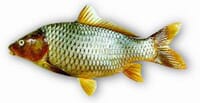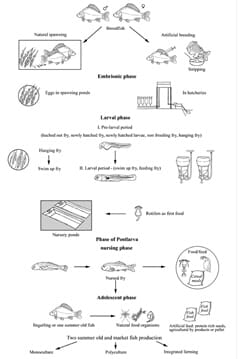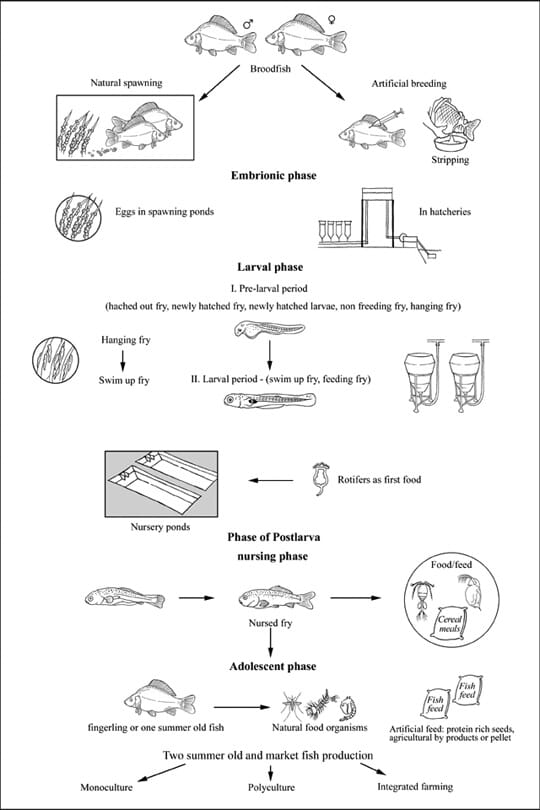Habitat and biology
Wild common carp (generally referred to as 'carp' in this fact sheet) live in the middle and lower streams of rivers, in inundated areas, and in shallow confined waters, such as lakes, oxbow lakes, and water reservoirs. Carp are mainly bottom dwellers but search for food in the middle and upper layers of the water body. Typical 'carp ponds' in Europe are shallow, eutrophic ponds with a muddy bottom and dense aquatic vegetation at the dikes.The ecological spectrum of carp is broad. Best growth is obtained when water temperature ranges between 23 °C and 30 °C.

The fish can survive cold winter periods. Salinity up to about 5 per cent is tolerated. The optimal pH range is 6.5-9.0. The species can survive low oxygen concentration (0.3-0.5 mg/litre) as well as supersaturation. Carp are omnivorous, with a high tendency towards the consumption of animal food, such as water insects, larvae of insects, worms, molluscs, and zooplankton. Zooplankton consumption is dominant in fish ponds where the stocking density is high.
Additionally, the carp consumes the stalks, leaves and seeds of aquatic and terrestrial plants, decayed aquatic plants, etc. The pond farming of carp is based on the ability of the species to accept and utilize cereals supplied by the farmers.
The daily growth of carp can be 2 to 4 percent of body weigh. Carps can reach 0.6 to 1.0 kg body weight within one season in the polycultural fish ponds of subtropical/tropical areas. Growth is much slower in the temperate zone: here the fish reach the 1 to 2 kg body weight after 2 to 4 rearing seasons. In Europe, female carp need about 11 000 to 12 000 degree-days to reach maturity in the temperate and subtropical climatic zones.
Male carp are matured within a period that is 25-35 percent shorter. The maturity period of Asian carp strains is slightly shorter. The spawning of European carp starts when the water temperature is 17-18 °C. Asian strains start to spawn when the ion concentration of the water decreases abruptly at the beginning of the rainy season. Wild carps are partial spawners. Domesticated carps release all their matured eggs within a few hours. After hormonal treatment carp release their ripe eggs within a much shorter period, which makes stripping possible. The quantity of released eggs is 100 to 230 g/kg body weight. The egg shell becomes sticky after contacting water.
The embryonic development of carp takes about 3 days at 20-23 °C (60-70 degree-days). Under natural conditions, hatched fry stick to the substrata. About three days after hatching the posterior part of the swim bladder develops, the larvae swim horizontally, and start to consume external food with a maximum size of 150-180 µm (mainly rotifers).
Production systems
Seed supply
Spawning on nests, aquatic weeds and inundated grass in tanks and ponds
Carp may spawn throughout the year in tropical areas of India, with peaks in January-March and July-August. Breeding is carried out in hapas, cement tanks or small ponds. Submerged aquatic plants are used as substrata for egg laying. When the fry are 4 to 5 days old, they are stocked into nursery ponds.
The 'Sundanese method' is used for spawning carp in Indonesia. The broodfish are kept in broodfish ponds, segregated by sex. Matured broodfish are transferred to 25-30 m² spawning ponds. 'Kakabans' (nests made of the fibre of Arenga species) are installed into the ponds. The fish lay their eggs on both sides of the kakabans. When spawning is completed, the nests are transferred to hatching/nursing ponds.
Small ponds are used for spawning carp in China. Aquatic weeds (Ceratophyllum, Myriophyllum) or floating palm leaves are used as spawning substrata.
Small 'Dubits ponds' (120-300 m² water surface area) were used for spawning, and for short nursing of carp fry in Europe in the past. More recently, ponds with an area from a few hundred m² up to 10-30 ha are used here. Two to four weeks after spawning, the fry can either be harvested from these large ponds, or may remain there up for rearing to fingerling size.
Hatchery based seed production
This is the most effective and reliable method of seed production. Broodfish are kept in water saturated with oxygen, within the temperature range of 20-24 ºC. They are given two doses of pituitary gland injection, or a mixture of GnRH/dopamine antagonist, to induce ovulation and spermiation. The eggs are fertilized (applying the 'dry method') and the adhesiveness of the eggs is eliminated using salt/urea treatment, followed by a tannin acid bath (the 'Woynarovich method'). Incubation is carried out in Zoug jars. The hatched fry are kept in large conical tanks for 1 to 3 days, and are usually stocked at the stage of 'swim-up' or 'feeding fry' into properly prepared ponds. Approximately 300 000 to 800 000 newly hatched fry can be expected from a single female.
Nursery
Nursing of common carp in ponds and tanks
Shallow, aquatic weed-free drainable ponds of 0.5 to 1.0 ha are the most suitable for carp nursing. Nursery ponds must be prepared before stocking to encourage the development of a rotifer population, since this constitutes the first food of feeding fry. The stocking density is 100-400 fry/m². The ponds should be inoculated with Moina or Daphnia after stocking. Supplementary feeds, such as soybean meal, cereals meals, meat meal, or mixtures of these materials, should be applied. Rice bran or rice polishings can also be used for feeding fry. The length of the nursery period is 3 to 4 weeks. The final fish weight is 0.2-0.5 g. The survival rate is 40-70 percent.
If there are many predators in the area where ponds would be situated (insects, snakes, frogs, birds, wild fish), tank nursing of carp can be applied. Tanks of 5-100 m² surface area, made of concrete, bricks or plastic, can be used for nursing fry up to 1-2 cm in size. By applying hay and manure, dense populations of Paramecium and rotifers can be established in these tanks. A few hundred fry per m² can be stocked. Collected zooplankton and fine particle size meals, or complete starter foods can be used. Industrial type systems, such as raceways, or water recirculating systems are also suitable for nursing.
Fingerling production
The production of carp fingerlings normally takes place in semi-intensive ponds, based on manure/fertilizer-generated natural food and supplementary feeding. Fingerling production can be carried out in a single stage system (stocking newly hatched fry and harvesting fingerlings), a dual stage system (stocking nursed fry and harvesting fingerlings), or a multicycle system (when newly hatched fry are stocked, and the fish are thinned out several times).
Stocking nursed fry is the most effective way for producing medium and large size fingerlings. Depending on the required final size of fingerlings, 50 000-200 000 nursed fry/ha can be stocked in temperate zones, preferably in polycultural systems where the proportion of common carp is 20-50 percent. The final weight of the carp is 30-100 g. In warm climates, if large size fingerlings are the production target, the stocking density of nursed fry is 50 000-70 000/ha, out of which the proportion of common carp is 20 percent. Survival rates of 40-50 percent are achieved. Small size fingerlings can be produced in ponds stocked with 400 000 small (15 mm) nursed fry. In this case the survival rate is 25-30 percent.
Frequent application of manure is necessary to maintain the plankton population. The feeding is based mainly on agricultural by-products in subtropical areas, on cereals and/or pellets in temperate zones.
Ongrowing techniques
Production of two summer-old carps
In temperate zones, one-summer old fish (20-100 g) must be reared up to 250-400 g in the second year. The stocking rate is 4 000-6 000/ha, plus about 3 000 Chinese carp/ha, if only cereals are fed. The stocking rate can be much higher (up to 20 000/ha) if cereals and pellets also used. The daily ration is approximately 3-5 percent of body weight.
Production of market size fish
Common carp can be produced in extensive, natural food and supplementary feed-based monocultural production systems, in stagnant water ponds. Artificial feed-based intensive monocultural production can be carried out in cages, irrigation reservoirs, and running water ponds and tanks, or in recirculation systems.
Common carp are stocked with Chinese carps, and/or Indian major carps, tilapia, mullet, etc., in polycultural systems. This constitutes a natural food and supplementary feed-based production method, in which fish that have different feeding habits and occupy different trophic niches are stocked into the same ponds. The quantity of fish should be in accordance with the productivity of natural food organisms. The frequent application of manure or fertilizers and the proper species ratio, make the maintenance of productive populations of natural food organisms, and the maximal utilization of the productivity of pond ecosystem possible. Synergetic effects between fish species support the production in polycultural ponds.
Carp culture can be integrated with animal husbandry and/or plant production. Integration can be direct (animals above fish ponds), indirect (wastes of animals are used in the ponds as manure), parallel (rice-cum-fish), or sequential (fish production between crops). The sequential cycling of fish/animal/legumes/rice (in 7 to 9 year cycles) is suitable for significantly decreasing the environmental loading of intensive aquaculture/agriculture. Since common carp burrow in the pond bottom, have a broad environmental tolerance and an omnivorous feeding habit, they are a key species in integrated systems.
Common carp can also be stocked into natural waters, reservoirs, and temporarily inundated areas, in order to utilize the natural food production of these waters for enhanced capture fisheries. In this case the fish stocked should be 13-15 cm fingerlings produced in fish farms ('aquaculture-based fisheries') in order to avoid the losses that would occur with smaller fish. Common carp are usually stocked with other cyprinid species, in accordance with the productivity of the water and the intensity of exploitation.
Feed supply
The use of natural food has been mentioned in other sections of this fact sheet. These are sometimes supplemented with compounded farm-made or commercial feeds.
Harvesting techniques
Undrainable ponds, or drainable ponds with a long harvesting ditch, or ponds with inner or outer harvesting pits are used for carp rearing. The fish are usually harvested by seine nets. The length of nets should be 1.5 times the width of ponds, but not longer than 120-150 m.
In undrainable ponds, selective harvesting can be done. The maximum weight of carp which can get through various mesh size nets are: 20 mm mesh size = 20 g fish; 25 mm = 40 g; 30 mm =100 g; 35 mm =170 g; 40 mm = 270 g; 50 mm = 400 g.
Since the carp keep mud-free the area where they search for food, feeding should be done throughout the growing period in the harvest area. At harvest time the water should be drained slowly (1-3 days from a 1 ha pond, 8-14 days from 30-60 ha ponds). The fish gather in the deepest area of the pond, unless they are frightened away by an abrupt decrease of water level, or by noises. Since carp tend to swim towards incoming water, a small quantity of water is flowed into the pond near the drainage site to concentrate the fish, especially if the water temperature is high. When a large quantity of fish is concentrated in the harvesting pits aeration should be supplied. Sprinkling water on the surface is usually not sufficient.
Partial harvesting (regardless whether the ponds are drainable or undrainable) increases the total production of the ponds by improving the conditions for the remaining population.
Handling and processing
If harvesting is carried out in warm water, the fish are pre-conditioned by repeated stressing before netting. Harvested fish can be transferred live in aerated tanks for 3-5 hours, if the fish/water ratio is not more than 1:2. The density of fish in transport tanks and the duration of transport depend on fish size, temperature and the amount of aeration.
If, during harvesting, fish have been enticed into the harvesting area by feed, only very short transport time is feasible, since the oxygen demand of satiated fish is high.
The majority of carps is transferred live to markets, and is sold either live or freshly dressed. Successful trials have been carried out on the large scale filleting of carp in France. Apart from value-added products, about 15 different products can be prepared from carp, representing different levels of processing.
Production costs
The average profit of carp production in some Hungarian fish farms was € 326/ha (from sales of € 1 652/ha) between 1999-2001, according to a survey by the Research Institute of Fisheries, Aquaculture and Irrigation (unpublished data). In India the net profit from polyculture, in which common carp represented 25 percent of the total fish stocked, was reported to be US$ 710/ha (from sales of US$ 1 929) in 1990 (Sinha,1990). The profit of small scale farmers in Bangladesh was reported to be US$ 510-1 580/ha (from sales of US$ 1 540-2 610/ha) from undrainable polyculture ponds, in which the stocking ratio of carp was 20 percent (Gupta et al., 1999).
January 2009






